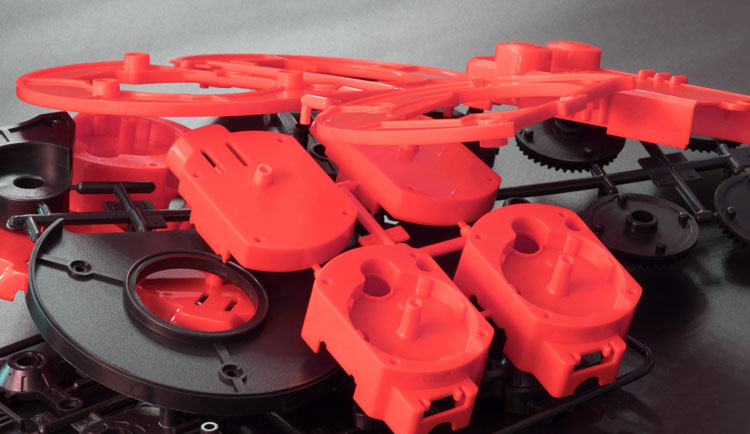What You Need to Know About Injection Molding
Injection molding has been around since the 1940s, when it was used to make plastic parts during World War II. Today, it’s one of the most popular manufacturing processes in the world and its popularity shows no signs of slowing down anytime soon. With recent advances in 3D printing technology and mold making, injection molding has become an even more viable option for small businesses.
The Process of Injection Molding
Injection molding consists of taking a polymer-based material and melting it before injecting it into a steel or aluminum cavity. The plastic melts and pressurizes with high heat and forces through a small hole, known as a sprue. When in liquid form, it will pass through small openings, known as gates, and fill up every nook and cranny of the injection molded part.
In order to consider injection molding, it must have three specific characteristics: First, the engineer must inject an exact amount of material into each cavity.
Second, there must be one or more gates on every part that allow for proper flow of material. Third, the engineer must create parts using an injection molding machine.
Engineers use these machines for both mass production and custom injection molds. From start to finish, there are a number of steps to using injection molding. Let’s take a look at each step individually
Step 1: Injecting Materials
Injection moulding is a manufacturing process that uses molten plastic to create a wide variety of parts. It works by injecting and heating plastic or other materials into molds. Engineers can use Injection molding for both consumer products and industrial uses.
Step 2: Gates Allow Proper Flow of Material
Gates are designed in different shapes and sizes, but all have one purpose: to regulate material flow. As material enters a mold, gates allow for precise control over how much is injected into specific areas of a part. Whether they’re simple or complex, gates can help determine how strong and durable your injection-molded parts will be.
Engineers can shape gates in different ways. This makes it possible for manufacturers to fine-tune injection-molding parameters and still guarantee an efficient and reliable flow of material into a part.
More advanced gates also enable manufacturers to inject different materials at certain locations within a part, enabling injection-molded products that are not only strong and durable but also lightweight and energy efficient.
Step 3: Creating the Parts
Injection molding is one of many plastic fabrication processes. An injection press uses two pistons, or plungers, to push a molten plastic into a mould that cools down in a water bath. Once in its mould, the plastic solidifies and cools back down into a solid part.
Of course, injection moulding is more complicated than that. Many factors influence how well a plastic part will produce and finish. Understanding these variables—from material selection and injection speed to mould design and clamping force—is essential for producing parts that look good and perform well.
Common Materials Injection Molding Uses
Injection molding commonly use certain plastics for creating material. These include high-density polyethylene, low-density polyethylene, linear low-density polyethylene, and other specialized types of thermoplastic like nylon and ABS. Engineers typically use these materials for large injection molds. Smaller devices also use materials like ABS and nylon too. Also, engineers can mold a variety of rubbers with an injection press, such as EPDM rubber.
ABS has a high-impact strength and is heat resistant. It is strong but flexible, so it is ideal for consumer goods and injection molds that will be cycled frequently. Injection molding is one of today’s most efficient and cost-effective methods for mass producing plastic parts.
Popular Industries That Use Injection Molding
The most common industries that use injection molding are automotive, defense, and healthcare. For example, nearly every car on the road today has components made through injection molding. Similarly, a majority of medical devices are manufactured using injection molds. In fact, injection molds produce over 20% of all plastic parts in vehicles. They also produce 40% of large plastic product and 50% of small plastic product such as medical devices or consumer products.
How to Choose a Mold-Maker?
There are a variety of factors to consider when choosing a service provider, from their experience and reputation to their manufacturing capabilities. In order to avoid costly mistakes and delays, it’s important that you carefully analyze your options before making a decision. Here’s what you should consider.
Because there are so many variables that involve injection-molding services, it’s difficult to put a set price on what you’ll pay. The price per part depends on factors like your material choice, your desired dimensions and tolerances, and how many parts you order. If you’re comparing quotes from several different companies, questions can include: How much experience do they have in injection molding? What certifications do they have? Are their manufacturing facilities ISO certified?
Why You Should Choose PartsBadger
If you’re looking for injection molding services, PartsBadger offers a variety of low-cost solutions to fit your needs. From prototype injection molds and short-run production parts, we offer cost-effective injection molding services that meet your budget and timeline. We have an ISO Certified team of engineers and manufacturing experts with experience in injection moulding design and tool making, guaranteeing our parts finish and deliver on time and better than expected.
About PartsBadger
From prototyping to manufacturing, let PartsBadger take care of your manufacturing needs. We’re here to help answer any questions you might have about our manufacturing techniques to get your custom parts made.
PartsBadger has state-of-the-art equipment like computer numerical control (CNC) mills, CNC lathes, laser cutters, water jet machines, die cast machines, sheet metal bending machines, 3D Printing, and more. This is the company that will give you the exact custom parts you need.
Contact us today for your quote or to find out more about our services.


Recent Comments